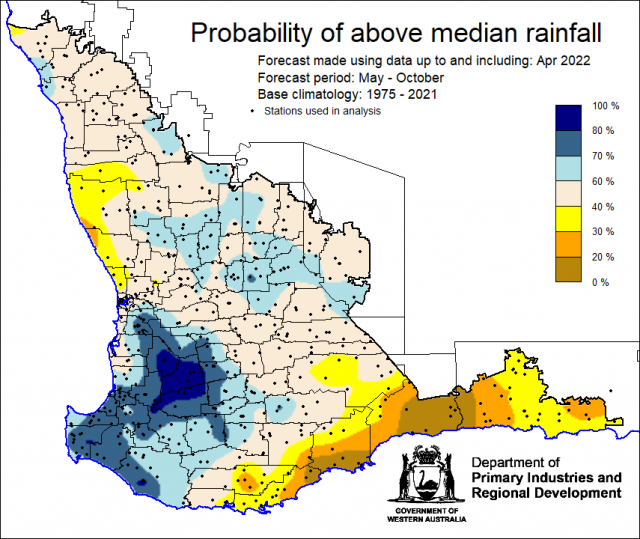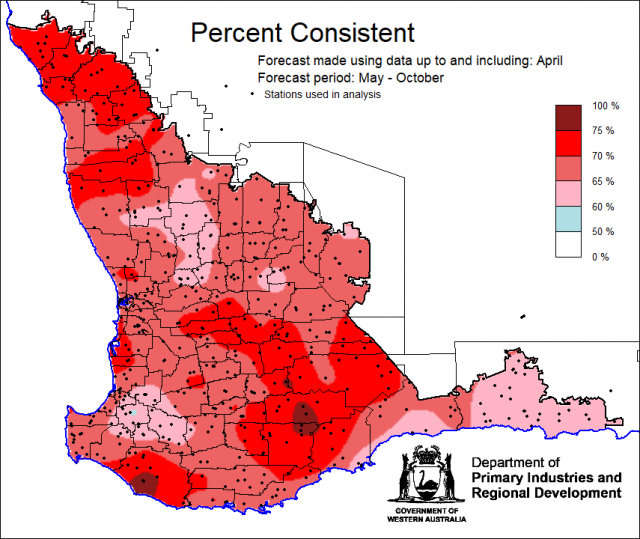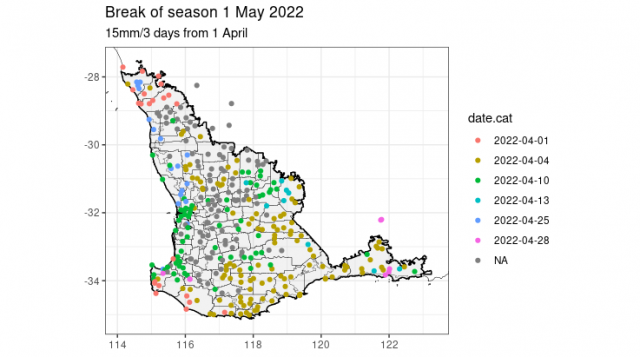SSF Forecast for May to October
The SSF forecast for SWLD May to October 2022 rainfall is indicating less than 40% probability of above median rainfall in South Coastal, South East Coastal and coastal parts of the Lower West and southern coastal parts of the Central West forecast districts. Above 60% for parts of the Central West, Central Wheatbelt and South West and western part of the Great Southern forecast districts, with neutral probability elsewhere. The most likely decile range map is indicating decile 2-3 for South Coastal and South East Coastal forecast districts. Decile 8-9 for South West, western part of the Great Southern, parts of the Central West and Central Wheatbelt forecast district. Decile 4-7 elsewhere. Skill is poor to good at 50 to 75 % consistent.


Recent climate
April rainfall was average to above average for the SWLD. Munglinup in the South East Coast forecast district, received 230 mm of rain. April maximum temperatures were mostly below average, with minimum temperatures average. The break of season map indicates an early break for the majority of the South West Land Division, with some locations in the northern and central grainbelt, still waiting for a break (haven’t received 15 mm over 3 days since 1 April).
In April the atmospheric pressure was normal over the SWLD.
In April, sea surface temperatures were warmer than average around tropical Australia. The May to July, sea surface temperature outlook by the Bureau of Meteorology indicates SSTs are likely to remain warmer than normal around Western Australia, indicating the possibility of the development of a negative Indian Ocean Dipole.
The Indian Ocean Dipole (IOD) is neutral. Models are indicating the development of a negative IOD in May and persisting until at least September at this stage. Past negative IOD events generally increase rainfall in the eastern grainbelt and bring cooler days to the south. However, model outlooks issued at this time of the year have low skill beyond autumn.
The Southern Annular Mode (SAM), also known as the Antarctic Oscillation (AAO), describes the north–south movement of the westerly wind belt that circles Antarctica, dominating the middle to higher latitudes of the southern hemisphere. SAM is currently positive and expected to remain positive until mid-May before returning to neutral. A positive SAM in autumn may suppress the activity of cold fronts in the Southern Ocean. For more information see the Bureau of Meteorology’s Climate Driver Update.
The 2021–22 La Niña event continues to weaken. However, atmospheric indicators remain above La Niña levels, continuing it’s influence, mostly on eastern Australian climate. Majority of models indicate a return to neutral ENSO conditions by June.
The table below gives a summary of past month and three-month South West Land Division (SWLD) climate conditions, and can indicate what is likely to occur in the near future if climate conditions follow the current pattern.
| Climate Indicator | Past month | Past 3 months |
|---|---|---|
| SWLD Rainfall | Average to above average | Average to above average |
| SWLD Mean Temperature | Average | Above average |
| SWLD atmospheric pressure | Normal | Normal |
| Indian Ocean Sea surface temperature | Warmer | Warmer |
| El Niño/Southern Oscillation (ENSO) | La Niña | La Niña |
| Indian Ocean Dipole (IOD) | Neutral | Neutral |
| Southern Annular Mode (SAM) | Positive | Positive |

